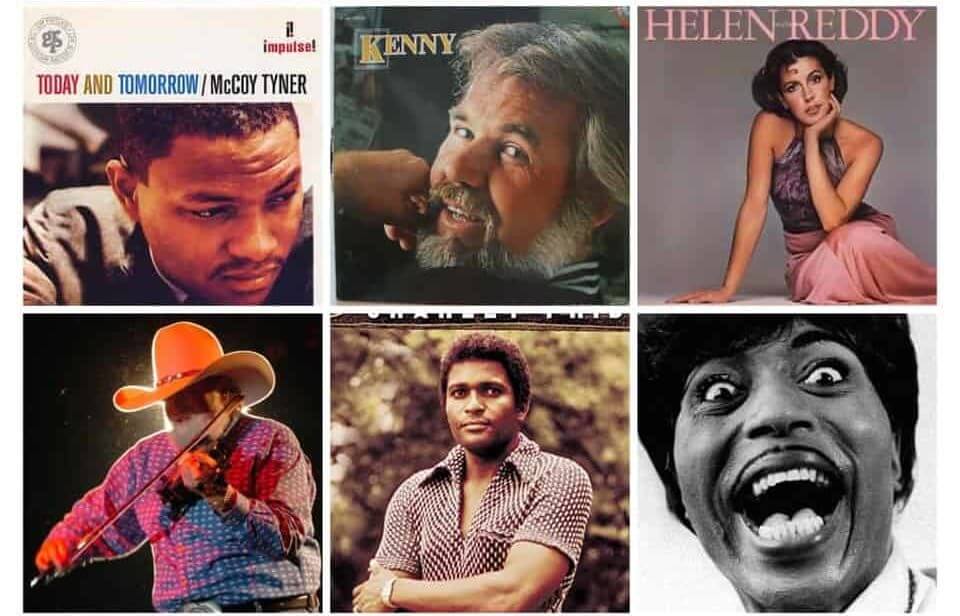We lost a lot of musicians in 2020. As we end a year that will forever be associated with death and dread, a final look back at some of the people who brought us joy with the music they created.
Little Richard would tell you – that he was the originator and the architect of rock and roll. Richard Penniman escaped rural Georgia by running away with the circus as a teenager. Indeed, by the time he made his way to New Orleans, he had created his own brand of music that featured the stomping of his hometown church congregation mixed with the fiery exuberance of a train chugging down the tracks near his house. He was a wild man. There was never anyone like him before, and there never will be one like him again.
Eddie Van Halen may have been one of the most musicianly men to ever wield a guitar. With his brother Alex on drums, Michael Anthony on bass, and David Lee Roth (later Sammy Hagar) on vocals, Van Halen created some of the most piledriving rock ever committed to vinyl – and looked and sounded as if they were having the time of their lives.
Charley Pride was an American success story. He played professional baseball in the Negro leagues of the 1950s, ending up in rural Montana and moonlighting at a country music bar. Before long, he was making records for Chet Atkins at the famous RCA Studio B in Nashville, and during a thirty-plus year peak at the top (1966-1988), he charted 52 country top ten hits – 30 of which made it to number one!
Neil Peart of Rush may have addressed science fiction, philosophy, and fantasy in his lyrics, but nobody could question the peerless musicianship of his drumming. Listen to “YYZ,” “Tom Sawyer,” “Distant Early Warning,” or any Rush songs and hear for yourself: he was the best.
With the New Christy Minstrels, the offshoot project First Edition, or on his own, Kenny Rogers ruled the pop and country charts in the 1970s and 1980s. He sold over 100 million records in his lifetime. His mass appeal epitomized the art of the crossover hit.
Charlie Daniels could play the fiddle. Or anything with a string on it. Beginning in the late 1970s, he began a 20-plus year run on the country and pop charts with songs that celebrated conservative American values, such as “In America” and “Still in Saigon.” He also sang about the hippie life in “Uneasy Rider.” But his lasting claim to fame has to be his showdown with Satan in “The Devil Went Down to Georgia,” a barn-burner of a song that no one ever seems to tire of hearing.
John Prine was the first major artist to die from Covid-19 this year. The singer-songwriter had been around for decades, earning the respect of other musicians for his ability to write music imbued with sincerity. A pair of fine examples: the bored housewife who longs for adventure in “Angel from Montgomery,” and the plea for kindness to the elderly in “Hello in There.”

Harold Reid of the Statler Brothers was one of my favorite bass vocalists of all time. His resonant voice held down the bottom of the Statlers’ gospel harmonies, and he brought the humor when needed. But as a songwriter, he cleverly covered more serious territory. Of their 58 charting hits, he wrote some big ones: “Class of ’57,” “Do You Remember These,” “Bed of Rose’s,” and “Flowers on the Wall.”
Bill Withers holds the record for the longest sustained note ever recorded on the song “Lovely Day,” in which he holds a high E for 18 seconds. He will be best remembered for “Lean On Me,” “Ain’t No Sunshine,” and other huge hits of the 1970s and 1980s.
Helen Reddy personified the struggle for women’s rights in the 1970s with “I Am Woman,” but had 15 other singles in the Top 40 over the years including “Angie Baby,” “You and Me Against the World,” and “Candle on the Water” (from the Walt Disney film Pete’s Dragon).
Mac Davis had it all: a movie career, his own television show, guest-starring roles everywhere. But he began as a struggling songwriter who had the good fortune to meet up with Elvis Presley. He wrote “Memories,” “In the Ghetto,” “A Little Less Conversation,” “I Believe in Music,” “Stop and Smell the Roses,” and many, many other classic songs.
Ellis Marsalis was a giant of New Orleans piano who brought jazz to the world as a teacher and ambassador of the genre. He also introduced his sons Wynton, Delfeayo, and Branford to the music world as well.
McCoy Tyner was also a jazz legend, having been a member of the John Coltrane Quartet in the 1960s. Lee Konitz played the saxophone in Miles Davis’ first great quintet, the group that recorded Birth of the Cool. Peter Green was one of the most influential British blues guitarists of the late 1960s and formed a band around his drummer (Mick Fleetwood) and bass guitarist (John McVie) which survives to this day as Fleetwood Mac.
Lennie Niehaus wrote music for Clint Eastwood movies and jazz bands everywhere. Ennio Morricone wrote for Clint, too – and everyone else. His “The Good, The Bad, and The Ugly” theme is still used whenever someone wishes to conjure an image of a dusty Western gunfight. Johnny Mandel wrote for thousands of TV shows and films, but his theme from “M*A*S*H” is still heard several times a day all over the world in reruns.
Eric Weissberg brought the banjo to the masses with his unforgettable hit “Dueling Banjos.” Bobby Lewis made “Tossin’ and Turnin’” the second-biggest hit of 1961 (behind “The Twist”). Robert Parker played with a lot of New Orleans luminaries, but had a hit of his own with “Barefootin’.” Emitt Rhodes was a multi-instrumentalist and, at one time, was called America’s answer to Paul McCartney. Wayne Fontana, with his band the Mindbenders, had a hit with “The Game of Love” in the mid-1960s. K.T. Oslin was a major figure in country, especially known for “80s Ladies.”
Jan Howard was a country legend, once married to songwriter Harlan Howard but famously partnered with Whisperin’ Bill Anderson on a string of hit duets. Chris Darrow was a country-rock pioneer as a member of the Nitty Gritty Dirt Band and Kaleidoscope. Joe Diffie charted 35 country singles, five of which went to #1. Hal Ketchum, another country success, was best known for “Small Town Saturday Night.”
Trini Lopez was a Mexican-American success story, especially with his version of “If I Had a Hammer.” Bonnie Pointer, as a member of The Pointer Sisters, ruled the radio with hits like “Jump (For My Love)” and “I’m So Excited,” but was also heard on the iconic Sesame Street pinball countdown.
Max Crook was an electronic music pioneer. The first recording to feature a synthesizer was his invention, the Musitron, on Del Shannon’s 1961 hit “Runaway.” Annie Ross was a member of the vocal jazz group Lambert, Hendricks & Ross, memorably turning in a unique performance on the song “Twisted.” Danish pianist and composer Bent Fabric will be remembered for his instrumental “Alley Cat” for years to come.
Ronald Bell wrote and produced most of Kool & the Gang’s hits, and served as their arranger, producer, saxophonist, and singer-songwriter. He wrote “Cherish,” “Jungle Boogie,” and famously “Celebration,” which was inspired by a hotel room Bible. Leslie West was physically imposing, and his guitar slinger skills will go down in history as a member of the band Mountain (“Mississippi Queen”).
Johnny Nash sang reggae but made it big with his smash hit “I Can See Clearly Now” in 1972. Toots Hibbert of Toots & the Maytals claimed to have coined the genre’s name, and is best known for the reggae hit “Pressure Drop.”
Herbert Kretzmer wrote the lyrics for the Broadway musical Les Miserables. Spencer Davis was a key figure of 1960s rock in England, and with his discovery of a teenaged Steve Winwood, had a string of hits: “Gimme Some Lovin’,” “I’m a Man,” and “Keep on Running” are still heard every few minutes on a device somewhere in the world.
Michael Bird is a longtime music teacher at Tallassee High School, radio host on WACQ-AM 580 & FM 98.5, and columnist for the Tallassee Tribune.
If you’d like to see your writing published on the Dogwood Journal, click here and submit your story!









